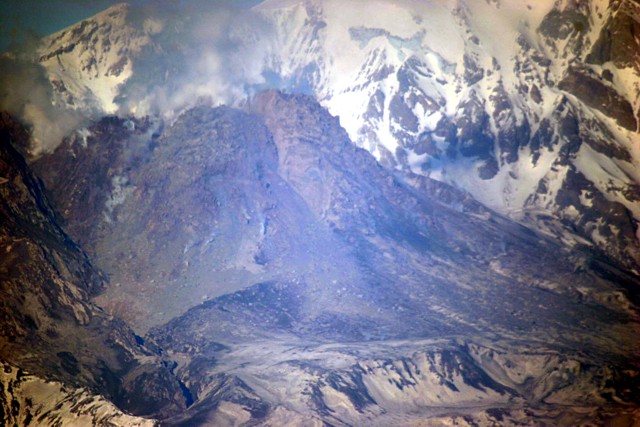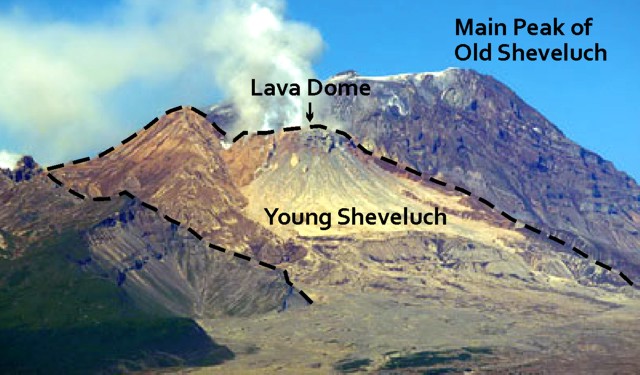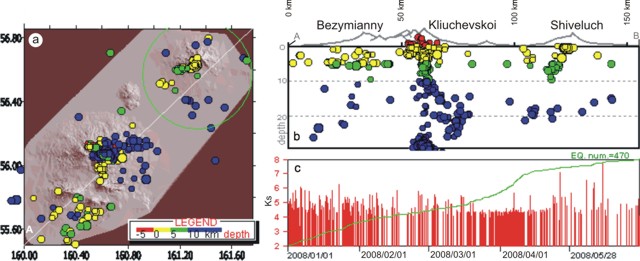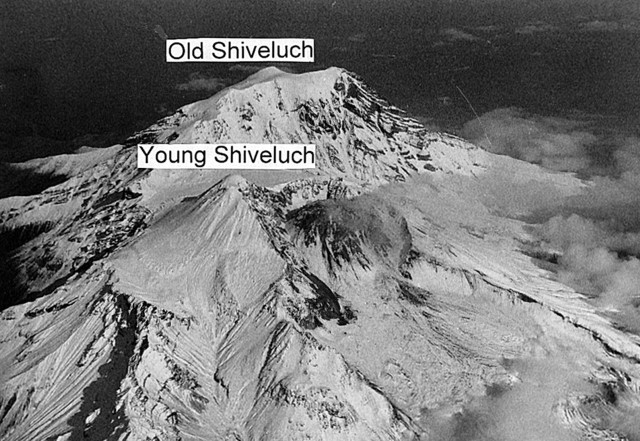Report on Sheveluch (Russia) — April 2008
Bulletin of the Global Volcanism Network, vol. 33, no. 4 (April 2008)
Managing Editor: Richard Wunderman.
Sheveluch (Russia) Emissions continue since January 2008 as lava dome grows; morphology
Please cite this report as:
Global Volcanism Program, 2008. Report on Sheveluch (Russia) (Wunderman, R., ed.). Bulletin of the Global Volcanism Network, 33:4. Smithsonian Institution. https://doi.org/10.5479/si.GVP.BGVN200804-300270
Sheveluch
Russia
56.653°N, 161.36°E; summit elev. 3283 m
All times are local (unless otherwise noted)
From the January to May 2008, dome growth at Shiveluch has consistently been accompanied by shallow, low-amplitude earthquakes, satellite thermal anomalies, and tremor. According to the Kamchatka Branch of the Geophysical Service of the Russian Academy of Sciences (KB GS RAS), several cases of elevated magnitude seismic signals occurred (figure 14). In some cases, these signals took place during times of zero visibility and the signals were interpreted to suggest a plume above to 4 km altitude.
On 3 March a plume of gas stretched 31 km to the SW of the volcano, and ash clouds rose up to ~ 4.5 km altitude. During the last two weeks of March, reports noted gas-and-ash emissions to ~ 3.5-4.5 km altitude; hot avalanches occurred each day (figure 15).
 |
Figure 15. The lava dome of Young Shiveluch as seen from the SE on 18 March 2008. A thick lava flow had recently extruded from the left (SW) side. Photo by Yuri Demyanchuk. |
Background on the edifice and deposits. Shiveluch is the northern-most active volcano of the Kamchatka peninsula, Russian Far East (figure 16a). The volcano forms a large isolated edifice surrounded by lowlands of the northern part of the Central Kamchatka depression. Two basic structural elements of the volcano are clear on figure 16b where Young Shiveluch is seen located inside the caldera of Old Shiveluch.
 |
Figure 16. Photo of the Shiveluch volcano complex in a view from the S. The dotted line divides the two structures of Old Shiveluch and the growing dome of Young Shiveluch. From Gorbach (2007). |
Old Shiveluch includes a thick sequence of basaltic and andesitic pyroclastic layers exposed in the base of the caldera wall; the NE and SW parts of the complex contain a folded sequence of pyroclastic deposits overlapped by basaltic-basaltic andesite flows and broken through by numerous radial dikes. The lava flows and domes of Young Shiveluch are richer in silica (59.5-62.5%) than those of Old Shiveluch (54.5-56.5%). Young Shiveluch (figures 16 and 17) has produced numerous Plinian tephras.
References. Belousov, A., Belousova, M., and Voight, B., 1999, Multiple edifice failures, debris avalanches and associated eruptions in the Holocene history of Shiveluch volcano, Kamchatka, Russia: Bulletin of Volcanology, v. 61, p. 324-342.
Gorbach, N., 2007, Bulletin of activity at Shiveluch volcano, (title approximate translated from Russian issued 31 July 2007) available (in Russian) at URL: http://www.kscnet.ru/ivs/volcanoes/inform_messages/2007/Shiveluch_072007/Shiveluch_072007.html).
Geological Summary. The high, isolated massif of Sheveluch volcano (also spelled Shiveluch) rises above the lowlands NNE of the Kliuchevskaya volcano group. The 1,300 km3 andesitic volcano is one of Kamchatka's largest and most active volcanic structures, with at least 60 large eruptions during the Holocene. The summit of roughly 65,000-year-old Stary Shiveluch is truncated by a broad 9-km-wide late-Pleistocene caldera breached to the south. Many lava domes occur on its outer flanks. The Molodoy Shiveluch lava dome complex was constructed during the Holocene within the large open caldera; Holocene lava dome extrusion also took place on the flanks of Stary Shiveluch. Widespread tephra layers from these eruptions have provided valuable time markers for dating volcanic events in Kamchatka. Frequent collapses of dome complexes, most recently in 1964, have produced debris avalanches whose deposits cover much of the floor of the breached caldera.
Information Contacts: Yuri Demyanchuk, Natasha Gorbsch, and theKamchatka Volcanic Eruptions Response Team (KVERT), Institute of Volcanology and Seismology, Far East Division, Russian Academy of Sciences, Piip Ave. 9, Petropavlovsk-Kamchatsky, 683006, Russia (URL: http://www.kscnet.ru/ivs/); Kamchatka Branch of the Geophysical Service of the Russian Academy of Sciences (KB GS RAS), Russia (URL: http://www.emsd.ru/); Alaska Volcano Observatory (AVO), a cooperative program of the U.S. Geological Survey, 4200 University Drive, Anchorage, AK 99508-4667, USA (URL: http://www.avo.alaska.edu/), the Geophysical Institute, University of Alaska, PO Box 757320, Fairbanks, AK 99775-7320, USA, and the Alaska Division of Geological and Geophysical Surveys, 794 University Ave., Suite 200, Fairbanks, AK 99709, USA.



